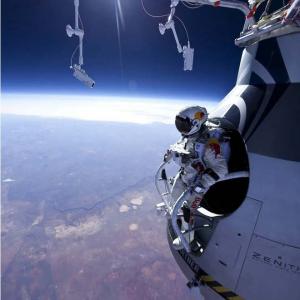College of Liberal Arts & Sciences
3B45.50 - Shock Wave Fronts - Supersonic Jump
Felix Baumgartner flew to an altitude of 39,045 meters (128,100 feet) in a helium-filled balloon on Oct 14, 2012. He then completed a record breaking jump from the edge of space. This was done exactly 65 years after Chuck Yeager first broke the sound barrier flying in an experimental rocket-powered airplane. He reached a maximum of speed of 1,357.6 km/h or 843.6 mph (Mach 1.25) through the near vacuum of the stratosphere before being slowed by the atmosphere later during his 4 minute 20 second long freefall. The 43-year-old Austrian skydiving expert also broke two other world records: highest freefall and highest manned balloon flight.
- Alexander Gossling, Sebastian Becker, Jochen Kuhn, "Hands-on Experiment for Modeling the Baumgartner Jump Using Free-Fall Kinematics with Drag", TPT, Vol. 59, #2, Feb. 2021, p. 111.
- Philip Blanco, "Computational Skydiving", TPT, Vol. 57, #6, Sept. 2019, p. 355.
- Tony Corvo, "An Analytical Solution to the Extreme Skydiver Problem", TPT, Vol. 57, #5, May 2019, p. 287.
- A. Müller, "Author's Response", TPT, Vol. 51, #5, May 2013, p. 261.
- Lukas Schellenberg, "Baumgartner's Terminal Velocity", TPT, Vol. 51, #5, May 2013, p. 261.
- Andreas Müller, "Supersonic Jump", TPT, Vol. 51, #1, Jan. 2013, p. 14.
- Pirooz Mohazzabi and James H. Shea, "High-Altitude Free Fall", AJP, Vol. 64, #10, Oct. 1996, p. 1242.
- José M. Colino, Antonio J. Barbero, and Francisco J. Tapiador, "Colino, Barbero, and Tapiador Reply", Physics Today, Vol. 67, #11, Nov. 2014, p. 10.
- David Wright, "The Discussion", Physics Today, Vol. 67, #11, Nov. 2014, p. 10.
- Alan Spero, "A Lead-In Paragraph", Physics Today, Vol. 67, #11, Nov. 2014, p. 9.
- Alfonso M. Gañán-Calvo, "Shock Waves and History in Free Fall", Physics Today, Vol. 67, #11, Nov. 2014, p. 9.
- José M. Colino, Antonio J. Barbero, and Francisco J. Tapiador, "Dynamics of a Skydiver's Epic Free Fall", Physics Today, Vol. 67, #4, Apr. 2014, p. 64.
- Jennifer Leman, "So You Want to Skydive From Space?", Popular Mechanics, May/June 2022, p. 40.
Disclaimer: These demonstrations are provided only for illustrative use by persons affiliated with The University of Iowa and only under the direction of a trained instructor or physicist. The University of Iowa is not responsible for demonstrations performed by those using their own equipment or who choose to use this reference material for their own purpose. The demonstrations included here are within the public domain and can be found in materials contained in libraries, bookstores, and through electronic sources. Performing all or any portion of any of these demonstrations, with or without revisions not depicted here entails inherent risks. These risks include, without limitation, bodily injury (and possibly death), including risks to health that may be temporary or permanent and that may exacerbate a pre-existing medical condition; and property loss or damage. Anyone performing any part of these demonstrations, even with revisions, knowingly and voluntarily assumes all risks associated with them.
